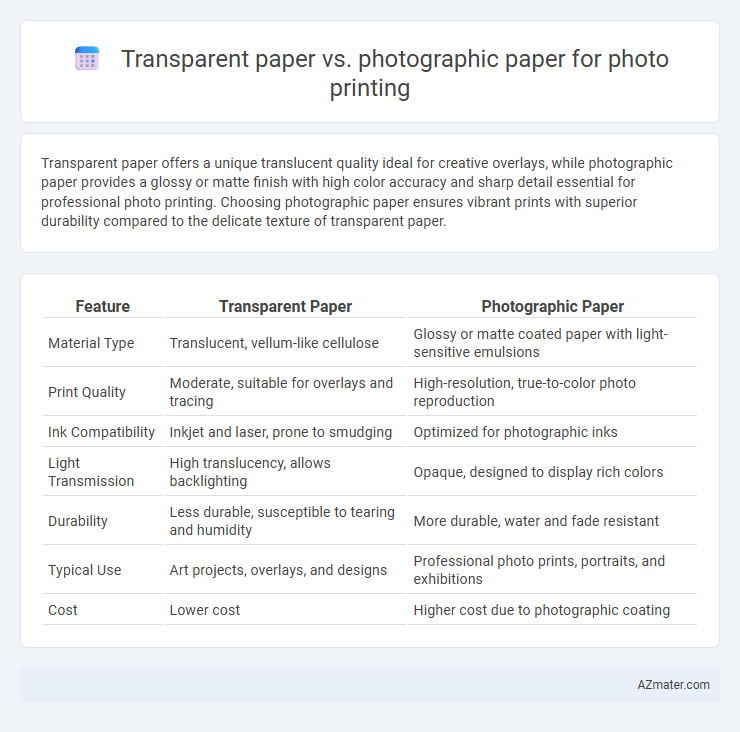Transparent paper offers a unique translucent quality ideal for creative overlays, while photographic paper provides a glossy or matte finish with high color accuracy and sharp detail essential for professional photo printing. Choosing photographic paper ensures vibrant prints with superior durability compared to the delicate texture of transparent paper.
Table of Comparison
| Feature | Transparent Paper | Photographic Paper |
|---|---|---|
| Material Type | Translucent, vellum-like cellulose | Glossy or matte coated paper with light-sensitive emulsions |
| Print Quality | Moderate, suitable for overlays and tracing | High-resolution, true-to-color photo reproduction |
| Ink Compatibility | Inkjet and laser, prone to smudging | Optimized for photographic inks |
| Light Transmission | High translucency, allows backlighting | Opaque, designed to display rich colors |
| Durability | Less durable, susceptible to tearing and humidity | More durable, water and fade resistant |
| Typical Use | Art projects, overlays, and designs | Professional photo prints, portraits, and exhibitions |
| Cost | Lower cost | Higher cost due to photographic coating |
Introduction to Photo Printing Papers
Photo printing papers vary significantly in texture, finish, and transparency, influencing the final image quality and presentation. Transparent paper, often used for overlays and creative effects, offers a unique translucent finish but lacks the vivid color depth and durability of photographic paper. Photographic paper is specifically designed to enhance color accuracy, sharpness, and longevity, making it the preferred choice for vibrant, high-quality photo prints.
What is Transparent Paper?
Transparent paper, also known as tracing paper, is a semi-translucent material made from cellulose fibers that permit light transmission, making it ideal for overlaying images or sketches in artistic and design applications. Unlike photographic paper, which is coated with light-sensitive chemicals designed to produce high-resolution and color-accurate photo prints, transparent paper lacks these coatings and is not suitable for direct photo printing. Its primary use in photo printing involves creating overlays or templates rather than serving as the final medium for photo prints.
What is Photographic Paper?
Photographic paper is a specially coated paper designed to produce high-quality, durable prints with vibrant colors and sharp details using inkjet or laser printers. Its surface is engineered to absorb ink efficiently, preventing smudging and enhancing image longevity. Unlike transparent paper, photographic paper delivers opaque, glossy, matte, or luster finishes that reproduce photographs with professional-grade clarity and color accuracy.
Key Differences: Transparent vs Photographic Paper
Transparent paper offers a translucent surface that allows light to pass through, making it ideal for overlays, tracing, and artistic effects, while photographic paper is designed with a light-sensitive coating to produce high-resolution, vibrant color prints with sharp details. Transparent paper lacks the glossy or matte finish typical of photographic paper, resulting in less color saturation and durability for photo prints. Photographic paper supports longer-lasting, fade-resistant images suited for professional-quality photography, contrasting with the delicate, often more affordable transparent paper used in creative projects.
Print Quality Comparison
Transparent paper offers a unique printing effect with light transmission properties, but photographic paper excels in color accuracy and sharpness due to specialized coatings that enhance ink absorption and color vibrancy. Photographic paper provides superior durability and resistance to fading, ensuring long-lasting, high-quality prints ideal for detailed photo reproduction. Transparent paper, while artistically distinctive, generally produces lower resolution images with less contrast compared to the crisp and vivid results achieved on photographic paper.
Use Cases: When to Choose Transparent Paper
Transparent paper excels in applications requiring layered or overlay printing, such as architectural blueprints, design proofs, or artistic transparencies. It allows for backlit displays and detailed presentations where light transmission enhances visual clarity and color vibrancy. For photo printing, choose transparent paper when creating materials intended for light boxes, slides, or specialized decorative projects needing translucency rather than the opacity and color depth typical of photographic paper.
Use Cases: When to Choose Photographic Paper
Photographic paper is ideal for preserving high-quality photo prints with vibrant colors, sharp details, and longevity, making it the preferred choice for professional portraits, wedding albums, and fine art reproductions. It offers superior ink absorption and gloss or matte finishes that enhance image depth and contrast, suitable for framing or display purposes. Choose photographic paper when durability and premium image clarity are essential for archival or presentation-quality photos.
Durability and Lifespan
Photographic paper offers superior durability and lifespan compared to transparent paper, resisting fading and damage from moisture or UV exposure due to specially coated surfaces. Transparent paper is more prone to yellowing, tearing, and color degradation over time, making it less suitable for long-term photo preservation. For archival-quality photo printing, photographic paper with acid-free properties ensures enhanced longevity and color stability.
Cost-Effectiveness and Availability
Transparent paper offers a more cost-effective option for photo printing due to its lower price point and widespread availability in office supply stores. Photographic paper, while providing superior image quality and color accuracy, tends to be more expensive and is often limited to specialty retailers or online platforms. For budget-conscious consumers seeking readily accessible materials, transparent paper presents a viable alternative despite its compromises in print fidelity.
Final Verdict: Which Paper is Best for Photo Printing?
Photographic paper offers superior color accuracy, durability, and glossy or matte finish options, making it the ideal choice for high-quality photo printing. Transparent paper, while useful for overlays and creative effects, lacks the vibrancy and archival properties required for professional photo prints. For lasting, vivid images with true-to-life detail, photographic paper is the best option.

Infographic: Transparent paper vs Photographic paper for Photo printing
 azmater.com
azmater.com